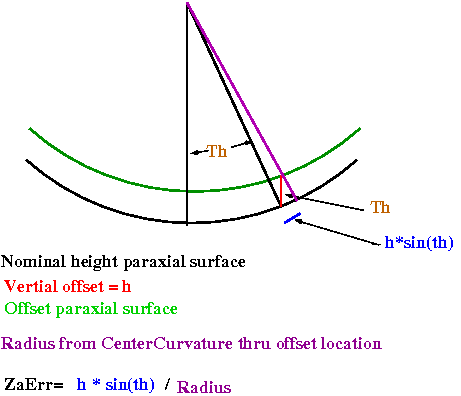Pointing error when platform moved
vertically
jun12
Sections:
The computed error
Comparing the measured and computed
error.
Plots:
the
computed pointing error for different vertical offsets (.ps) (.pdf):
the
measured platform height offset and pointing error (.ps) (.pdf):
Idl routines:
The error when moving the
platform vertically.
When the platform is moved vertically, the feed moves away
from the paraxial surface. This introduces a pointing error. This
error occurs during warm weather when the platform sinks below the
focus position and there is no tiedown tension left to push it back
up.
The Figure below shows the error:

When the platform moves up, the za pointing error is positive (as if
the dome was at a higher za). To correct for this error, you need to
subtract the za Error from the requested za position.
To first order, the azimuth error is not affected
by moving the platform vertically (the motion is azimuthally
symmetric)
The plots show the computed pointing
error for different vertical offsets (.ps) (.pdf):
- The different height offsets are coded by color.
- The top half of the plots show when the platform is above the
focus position.
- the bottom half of the plot has platform positions below the
focus position.
processing:
x101/120615/pntErrVsHght.fig, 120529/pnterrplat.pro
Comparing the computed error with
the measured error.
On 15jun12 a calibration run was done using
the cband receiver. It consisted of:
- It was a few weeks after pointing model18A was installed.. so
the pointing should have been pretty good.
- Prior to the start of the run, the distomat cpu stopped
updating the file containing the platform height.
- The online platform height tracking algorithm switched to
use the air temperature.
- The temperature algorithm is not as accurate as the
distomats, so the platform was a little high or low.
- The next day we fixed the communications problem, and all of
the distomat data from during the calibration run was
recovered.
- This gave us a dataset of a pointing run with
simultaneous info on the vertical error in the platform
position
The plots show the measured
platform height offset and pointing error (.ps) (.pdf):
- Page 1: pointing error vs az,za
- Frame 1,2: za error vs za and az
- Frame 3,4: az error vs za and az.
- black * is B2128+048, Red is source B2337+220
- The mean za error is 6.0 asecs
- The mean az error is .299 Asecs.
- Page 2 height offsets and errors:
- Top: The platform height offset vs hour of day.
- 2nd: The Za position of the two source tracks vs hour of day
- 3rd: overplot pointing error and computed height error.
- * black: measured
az pointing error,.
- *
red: measured za pointing error.
- *
green: za error computed from the height offset
- The height error tracks the za error. It is not correlated
with the az error.
- bottom: za error with height error removed.
- The mean za error is not .032 asecs. This is much closer
to what the model predicted.
Summary:
- The pointed error computed from the height offset matches the
measured za error offsets when the platform is offset in height.
- The platform height offset does not affect the azimuth error.
- If you have an offset in the tiedown motion:
- tiedown motions are 1.7 times larger than the platform
motions (cable boom stretch,rotating).
processing: x101/120615/x102cb.pro
<-
page up
home_~phil
